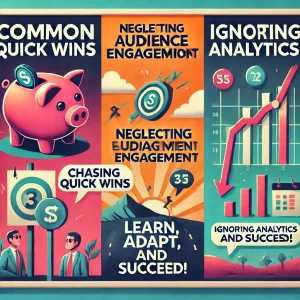Can You Really Succeed in Affiliate Marketing? A Realistic Look at the Odds
The Allure and Reality of Affiliate Marketing
Affiliate marketing captures the imagination of many aspiring entrepreneurs. The allure lies in its promise: earning passive income from anywhere in the world, with minimal overhead and no need to manage inventory or customer service. It’s a dream of financial freedom and flexibility, where you wake up to commissions earned overnight while pursuing your passions or traveling the globe. This vision, perpetuated by countless success stories, has inspired millions to try their hand at affiliate marketing.
However, the reality is far more nuanced. While the opportunity is real, achieving sustainable success requires a blend of hard work, strategic thinking, and unwavering patience. Many new affiliate marketers dive in, expecting immediate results, only to become discouraged by the steep learning curve. Building a profitable affiliate business takes time—months, even years—of consistent effort to develop valuable content, drive traffic, and optimize conversions.
Moreover, the field is highly competitive. To stand out, affiliate marketers must master skills such as search engine optimization (SEO), social media marketing, and data-driven decision-making. The truth is, affiliate marketing is not a “get-rich-quick” scheme; it’s a legitimate business model that rewards dedication and persistence. Understanding both its allure and its reality is the first step toward success.
The Dream: Passive Income and Location Independence
Affiliate marketing offers a compelling dream: earning a steady income with minimal effort, regardless of your location. The simplicity of the model is its biggest draw—you recommend products or services, drive sales through your unique affiliate links, and earn commissions, all without worrying about inventory, shipping, or customer service. It’s a business setup that requires only a laptop and an internet connection, making it an ideal choice for digital nomads or those seeking financial freedom.
The promise of passive income is especially enticing. You can create content, such as blog posts, videos, or email campaigns, that works for you around the clock. As your audience grows and your traffic increases, so do your earnings. For many, this lifestyle represents the ultimate goal—escaping the constraints of a traditional 9-to-5 job and achieving the freedom to work from anywhere in the world, on your own terms.
The Grind of Affiliate Marketing: Hard Work, Patience, and Persistence
While the dream of affiliate marketing inspires countless individuals, the reality behind it often surprises newcomers. Success in this field is rarely instantaneous and is built on a foundation of hard work, strategic planning, and unwavering persistence. The early stages can be especially challenging—developing quality content, building an audience, and driving traffic often yield slow and sporadic results at first. It’s a marathon, not a sprint, and many abandon the journey when quick wins don’t materialize.
Patience is a critical trait for aspiring affiliate marketers. Consistently refining your strategies, learning from setbacks, and staying motivated despite obstacles are all part of the process. Additionally, resilience is key; you’ll likely face rejections, algorithm changes, and competitive pressures. Those who succeed in affiliate marketing understand that the grind is a necessary step toward achieving the freedom and passive income they desire, making persistence the ultimate differentiator.
Setting Realistic Expectations In Affiliate Marketing: Redefining Success
For some, success might mean earning a full-time income. For others, it could mean a side hustle that pays for occasional luxuries. By setting clear, realistic goals, you’ll stay motivated through challenges and better appreciate your achievements.

The Competitive Landscape of Affiliate Marketing
Affiliate marketing is a highly competitive field, and breaking through the noise requires a strategic approach. With thousands of marketers vying for attention in popular niches like fitness, technology, and personal finance, standing out can feel daunting. Many markets are saturated with well-established players who have built loyal audiences over time. However, competition doesn’t mean impossibility—it means opportunity for those willing to innovate.
Success starts with niche selection. Instead of targeting broad, overpopulated markets, identify sub-niches where demand is high, but competition is manageable. For instance, instead of targeting “fitness,” focus on “home fitness for seniors” or “beginner yoga gear.” Conduct thorough research to uncover gaps that others might have overlooked, and align your choice with your expertise and passion.
Additionally, excelling in the competitive landscape requires an impeccable online presence. High-quality content, search engine optimization (SEO), and active social media engagement are essential tools for building credibility and attracting traffic. When paired with a deep understanding of your audience’s needs and preferences, these strategies can help you carve out a space in even the most crowded niches. With dedication and a unique approach, the competitive nature of affiliate marketing becomes a challenge worth conquering.
Navigating Market Saturation: The Power of Niches in Affiliate Marketing
While affiliate marketing is undeniably crowded, finding success is still possible for those who embrace the power of specialization. Instead of trying to appeal to everyone, focus on a niche that aligns with your interests and expertise while filling a specific gap in the market. Specialization allows you to connect with a more targeted audience, building trust and authority in your chosen area.
Popular niches like fitness, personal finance, travel, and technology offer significant opportunities, but they’re also highly competitive. To stand out, go deeper: instead of targeting “fitness,” explore sub-niches like “fitness routines for new moms” or “affordable home gym equipment.” Conduct thorough research using tools like keyword planners, competitor analysis, and market surveys to identify underserved areas that resonate with potential buyers.
By narrowing your focus, you can craft content that directly addresses the unique needs of your audience. This strategy not only increases your relevance but also improves your chances of driving conversions in a saturated marketplace. Niches aren’t just about limiting your audience—they’re about sharpening your value and setting yourself apart in the competitive landscape of affiliate marketing.
Establishing Your Online Presence: SEO, Websites, and Social Media
Your website is your digital storefront, and optimizing it for search engines (SEO) is vital to attract organic traffic. Use platforms like social media to connect with your audience, showcase your expertise, and drive visitors to your content. A cohesive online presence builds trust and enhances your visibility.
Investing in Essential Tools
The right tools can make your affiliate marketing efforts more effective. For instance:
- Website hosting: Ensures a fast and reliable experience for users.
- Email Marketing software: Helps nurture relationships with subscribers.
- Analytics tools: Provides insights into performance.
- SEO software: Aids in identifying and targeting the right keywords.
Investing in these resources can accelerate your journey to success.
Key Factors in Affiliate Marketing Success
Choosing the Right Affiliate Programs
Not all affiliate programs are created equal. Look for programs with transparent commission structures and products that genuinely align with your niche. The better the fit between your audience’s interests and the products you promote, the higher your conversion rates.
Creating High-Quality Content That Converts
Content is the lifeblood of affiliate marketing. Produce informative, engaging, and actionable content tailored to your audience’s needs. Use diverse formats such as blogs, videos, and infographics to keep your audience interested. The more value you provide, the more likely your audience is to trust your recommendations.
Embracing Data-Driven Optimization
Success requires constant improvement. Track metrics like traffic, click-through rates, and conversions to evaluate what’s working. Use tools to analyze your data and refine your strategies. A willingness to pivot when necessary can be a game-changer.
Strategies to Build a Profitable Business
Building a profitable affiliate marketing business requires a blend of strategic traffic generation, audience engagement, and partnerships that amplify your reach. Here’s how to implement these key strategies effectively:
Driving Targeted Traffic
Getting the right people to your site is essential for conversions. Focus on these methods:
- SEO (Search Engine Optimization): Optimize your content with relevant keywords, meta descriptions, and quality backlinks to improve search engine rankings. Create valuable, evergreen content that addresses your audience’s needs and keeps driving traffic over time.
- PPC Advertising (Pay-Per-Click): Use platforms like Google Ads or Facebook Ads to target specific demographics and quickly attract potential buyers. While paid advertising requires a budget, it can yield immediate traffic if done correctly.
- Social Media Marketing: Leverage platforms like Instagram, Facebook, and LinkedIn to share your content, engage followers, and build brand visibility. Use consistent posting schedules and tailored content to expand your reach.
Building an Email List and Nurturing Subscribers
Email Marketing remains a cornerstone of affiliate marketing success. By creating a subscriber list, you establish a direct communication channel to nurture relationships over time.
- Offer a free lead magnet, such as an eBook or webinar, to entice sign-ups.
- Send valuable, engaging emails that solve problems and provide insights.
- Strategically incorporate product recommendations into your email campaigns, ensuring they feel helpful rather than pushy.
Leveraging Influencer Partnerships
Influencers can turbocharge your affiliate marketing efforts by introducing your content or products to their established audiences.
- Identify influencers whose followers align with your niche.
- Build authentic relationships by engaging with their content before pitching collaborations.
- Structure deals that benefit both parties, such as affiliate partnerships where influencers earn a commission or flat fee for promoting your products.
By combining these strategies, you can drive traffic, foster relationships, and amplify your reach—paving the way for sustainable affiliate marketing success.
Common Pitfalls to Avoid

Even with the best intentions, aspiring affiliate marketers can fall into traps that hinder their success. Avoid these common pitfalls to build a sustainable and profitable business:
Chasing Quick Wins Instead of Sustainability
The allure of fast profits often tempts beginners to prioritize short-term gains over long-term growth. However, affiliate marketing thrives on consistency and strategy. Instead of promoting random high-paying products, focus on building a strong foundation:
- Create valuable, evergreen content that provides solutions and builds trust with your audience.
- Prioritize authenticity by recommending products that genuinely align with your niche and resonate with your audience’s needs.
Sustainability requires patience, but the rewards of a loyal, engaged audience far outweigh fleeting profits.
Neglecting Audience Engagement
Audience engagement is the heartbeat of affiliate marketing success. Simply posting content isn’t enough; you must actively connect with your audience:
- Respond to comments and messages on your blog and social media.
- Ask for feedback and address their pain points through tailored content or recommendations.
An engaged audience not only converts more effectively but also advocates for your brand, driving organic growth.
Ignoring Analytics
Failing to leverage data is like flying blind. Analytics provide actionable insights into what’s working and what isn’t. Regularly monitor key metrics, such as:
- Traffic Sources: Understand where your audience is coming from and double down on successful channels.
- Click-Through Rates (CTR): Analyze which content drives clicks and which needs optimization.
- Conversion Rates: Pinpoint the most effective strategies for turning traffic into sales.
By embracing a data-driven approach, you can refine your tactics, uncover untapped opportunities, and ensure continuous improvement in your affiliate marketing journey.
Conclusion: Paving Your Path to Success
Key Takeaways
Affiliate marketing is not a get-rich-quick scheme. It requires hard work, adaptability, and consistent effort. By focusing on your niche, creating valuable content, and leveraging analytics, you can build a sustainable income stream.
Action Steps to Get Started
- Research your niche thoroughly.
- Build a website and optimize it for SEO.
- Start creating high-quality content.
- Join affiliate programs that align with your niche.
- Use data to refine your strategy and scale your efforts.
Affiliate marketing success is achievable for those willing to put in the work. Approach it with patience and persistence, and you’ll be well on your way to reaching your goals.


